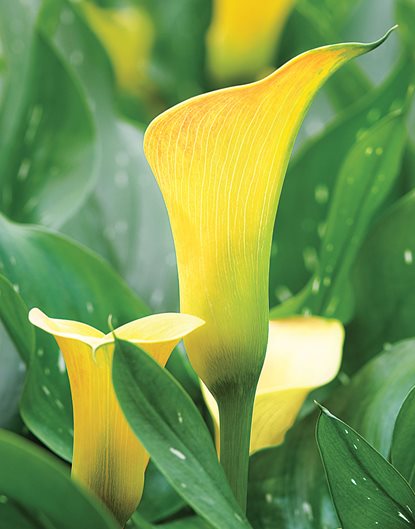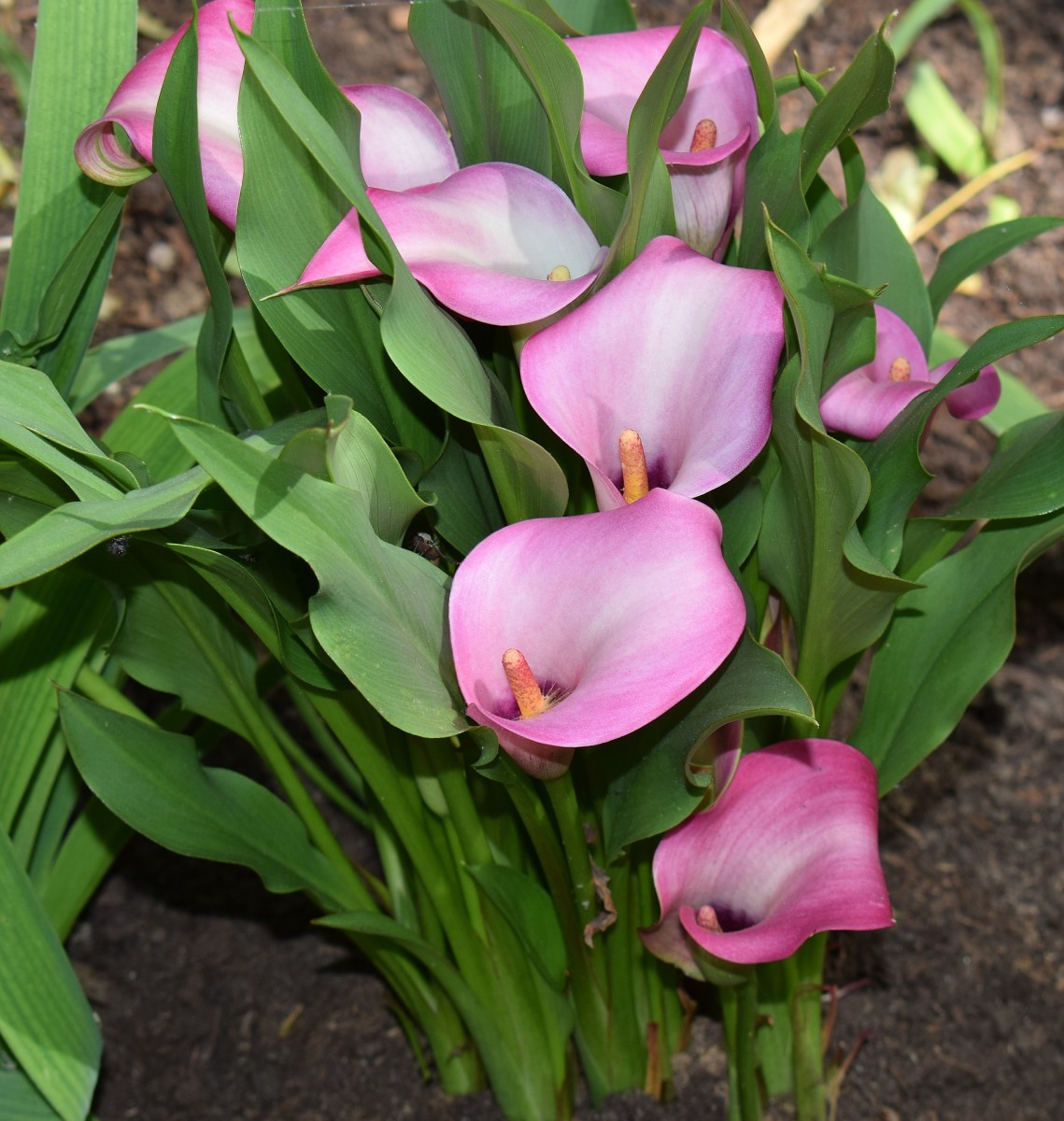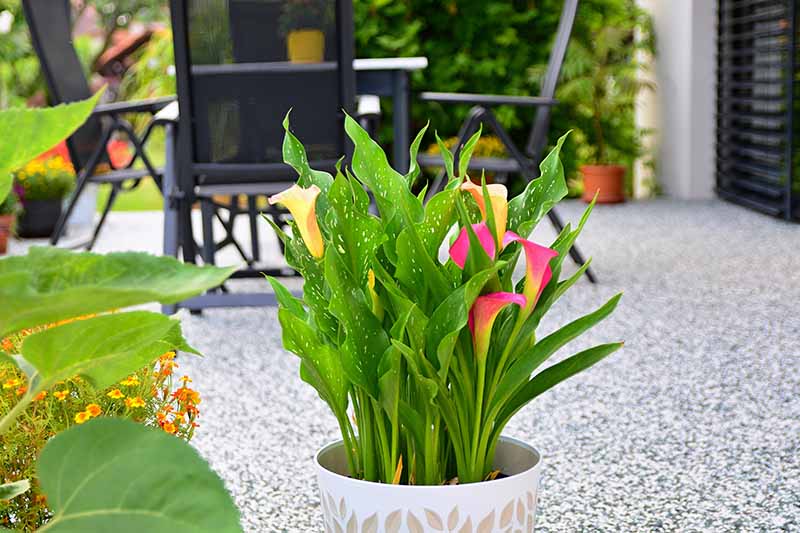Choosing the Perfect Spot: Calla Lily Placement and Soil
When it comes to how to care for calla lily outdoors, selecting the right location is crucial for their survival and thriving. Calla lilies require a spot that receives the right amount of sunlight, has a suitable temperature, and is planted in well-draining soil. Placing your calla lily in a location that receives full sun to partial shade will promote healthy growth and blooming. However, it’s essential to avoid direct sunlight during the hottest part of the day to prevent scorching.
In terms of temperature, calla lilies prefer temperatures between 65°F to 75°F (18°C to 24°C). Avoid placing them near heating or cooling vents, fireplaces, or drafty windows. When it comes to soil, calla lilies thrive in well-draining potting mixes that are rich in organic matter. A mix specifically designed for bulbs or rhizomes would be an excellent choice. To prepare the soil, add a 2-inch layer of compost or well-rotted manure to improve drainage and fertility.
Choosing a suitable pot is also vital for outdoor calla lily care. Select a pot that is at least 6-8 inches deep and has drainage holes in the bottom. This will ensure that the soil drains properly and prevent waterlogged soil. Consider using a pot that is slightly larger than the previous one to give the roots room to grow. By selecting the right location, soil, and pot, you’ll be well on your way to creating an ideal environment for your outdoor calla lily to thrive.
Watering Wisdom: Avoiding Overwatering and Underwatering
When it comes to how to care for calla lily outdoors, watering is a crucial aspect that requires attention to detail. Overwatering and underwatering are two common mistakes that can lead to poor calla lily care. Overwatering can cause root rot, while underwatering can lead to wilted leaves and stunted growth. To avoid these issues, it’s essential to determine the right watering schedule for your outdoor calla lilies.
To check soil moisture, stick your finger into the soil up to the first knuckle. If the soil feels dry, it’s time to water. If it’s already moist, wait another day before watering again. Adjust your watering schedule according to weather conditions. During hot and dry weather, calla lilies may require more frequent watering. In cool and rainy weather, they may need less water.
Another way to determine the right watering schedule is to observe your calla lily’s behavior. If the leaves start to droop or the flowers begin to wilt, it may be a sign that the plant needs more water. On the other hand, if the leaves are firm and the flowers are upright, it may indicate that the plant has enough water.
It’s also important to water your calla lily correctly. Water at the base of the plant, avoiding the leaves and flowers to prevent fungal diseases. Use lukewarm water, as cold water can shock the roots. Finally, avoid getting water on the crown of the plant, where the leaves meet the stem, to prevent rot.
By following these tips, you can ensure that your outdoor calla lily receives the right amount of water, avoiding the consequences of overwatering and underwatering. Remember, when in doubt, it’s always better to err on the side of caution and underwater slightly, as this can be corrected more easily than overwatering.
Fertilizing for Success: Nourishing Your Outdoor Calla Lilies
Fertilizing is an essential aspect of how to care for calla lily outdoors, as it provides the necessary nutrients for healthy growth and blooming. Outdoor calla lilies require a balanced fertilizer that is rich in phosphorus, nitrogen, and potassium. A 10-10-10 or 20-20-20 fertilizer formula is ideal for promoting healthy growth and blooming.
When it comes to how often to fertilize, it’s best to fertilize outdoor calla lilies during the growing season, which is typically from spring to fall. Fertilize every 4-6 weeks, using a water-soluble fertilizer at half the recommended strength. This will prevent burning the roots and ensure that the fertilizer is absorbed slowly.
It’s also important to avoid overfertilization, which can lead to weak growth, leaf burn, and reduced blooming. Start with a small amount of fertilizer and gradually increase as needed. Additionally, avoid fertilizing during the dormant season, as this can cause the plant to grow weak and leggy.
Another tip for fertilizing outdoor calla lilies is to use organic matter such as compost or well-rotted manure. These natural fertilizers release nutrients slowly, providing a steady supply of nutrients to the plant. They also improve soil structure, increase water retention, and support beneficial microorganisms.
By fertilizing your outdoor calla lilies correctly, you can promote healthy growth, encourage blooming, and enjoy a beautiful display of flowers throughout the growing season. Remember to fertilize sparingly, as overfertilization can have negative consequences. With the right fertilizer and frequency, you can create a thriving outdoor calla lily garden that will bring joy and beauty to your outdoor space.
Pest Control and Disease Prevention: Common Issues and Solutions
When it comes to how to care for calla lily outdoors, pest control and disease prevention are crucial aspects to consider. Outdoor calla lilies are susceptible to various pests and diseases that can weaken the plant and reduce blooming. In this section, we’ll discuss common issues and provide guidance on how to prevent and treat them.
Aphids, spider mites, and mealybugs are common pests that can infest outdoor calla lilies. These pests can cause curled or distorted leaves, stunted growth, and reduced blooming. To prevent pest infestations, inspect your plants regularly, and use organic pest control methods such as neem oil or insecticidal soap.
Root rot, leaf spot, and crown rot are common diseases that can affect outdoor calla lilies. These diseases are often caused by overwatering, poor drainage, and high humidity. To prevent diseases, ensure good air circulation, water carefully, and avoid getting water on the leaves or crown. If you notice any signs of disease, remove infected areas, and treat with a fungicide.
Another important aspect of pest control and disease prevention is maintaining good garden hygiene. Remove weeds and debris, which can harbor pests and diseases, and disinfect your pruning tools regularly. By taking these precautions, you can reduce the risk of pest infestations and diseases, and create a healthy environment for your outdoor calla lilies to thrive.
Regular monitoring and prompt action are key to preventing the spread of pests and diseases. Keep an eye out for signs of infestation or infection, and take action quickly to prevent further damage. By being proactive and taking preventative measures, you can enjoy a healthy and thriving outdoor calla lily garden.
Pruning and Grooming: Maintaining Your Calla Lily’s Appearance
Pruning and grooming are essential aspects of how to care for calla lily outdoors. Regular pruning and grooming help maintain the plant’s appearance, promote healthy growth, and encourage blooming. In this section, we’ll discuss the importance of pruning and grooming outdoor calla lilies and provide tips on how to do it effectively.
One of the most important pruning tasks is removing dead or dying flowers. This helps direct the plant’s energy towards producing new blooms and prevents the spread of disease. Simply cut off the dead flowers at the base, making sure not to damage the surrounding foliage.
Trimming back foliage is another crucial aspect of pruning and grooming outdoor calla lilies. This helps maintain the plant’s shape, promotes healthy growth, and encourages new blooms. Use clean, sharp pruning tools to trim back the foliage, making sure to remove any dead or damaged leaves.
Pruning and grooming also involve promoting healthy growth. This can be achieved by providing support for the plant, such as stakes or trellises, and ensuring good air circulation. Good air circulation helps prevent disease and promotes healthy growth, while support helps keep the plant upright and encourages blooming.
When it comes to how to care for calla lily outdoors, pruning and grooming are critical components. By regularly pruning and grooming your outdoor calla lilies, you can maintain their appearance, promote healthy growth, and encourage blooming. Remember to prune and groom your plants regularly, and provide the necessary support and care to ensure they thrive.
Protecting Your Calla Lilies from Extreme Weather
Extreme weather conditions can be detrimental to outdoor calla lilies, causing damage, stress, and even death. As part of how to care for calla lily outdoors, it’s essential to take measures to protect your plants from frost, heatwaves, strong winds, and other extreme weather conditions.
Frost is a significant threat to outdoor calla lilies, especially in colder climates. To protect your plants from frost, bring them indoors or move them to a frost-free area. If this isn’t possible, cover the plants with a frost blanket or sheet to insulate them. Remove the covering during the day to allow for air circulation and prevent moisture buildup.
Heatwaves can also be devastating to outdoor calla lilies, causing dehydration and stress. To protect your plants from heatwaves, provide shade, especially during the hottest part of the day. Mulch around the base of the plants to retain moisture and keep the soil cool. Water your plants regularly, but avoid overwatering, which can exacerbate the effects of heat stress.
Strong winds can cause physical damage to outdoor calla lilies, knocking them over or breaking their stems. To protect your plants from strong winds, stake them securely, using soft ties to avoid damaging the stems. Bring potted plants to a sheltered location, such as a patio or courtyard, to reduce wind exposure.
In addition to these specific measures, it’s essential to monitor weather forecasts and be prepared to take action when extreme weather is predicted. By taking proactive steps to protect your outdoor calla lilies from extreme weather conditions, you can ensure their health, beauty, and longevity.
Common Mistakes to Avoid When Caring for Outdoor Calla Lilies
When it comes to how to care for calla lily outdoors, there are several common mistakes that can lead to poor plant health, reduced blooming, and even plant death. By being aware of these mistakes, you can take steps to avoid them and ensure your outdoor calla lilies thrive.
One common mistake is neglecting to repot outdoor calla lilies regularly. Calla lilies need to be repotted every 2-3 years to provide fresh soil and a larger pot if necessary. Failing to repot can lead to root bound, reduced growth, and decreased blooming.
Another mistake is ignoring signs of pests or disease. Outdoor calla lilies are susceptible to pests like aphids, spider mites, and mealybugs, as well as diseases like root rot and leaf spot. Failing to identify and treat these issues promptly can lead to the spread of disease and pest infestations.
Failing to adjust to changing weather conditions is another common mistake. Outdoor calla lilies need to be protected from extreme weather conditions like frost, heatwaves, and strong winds. Failing to provide protection can lead to plant damage, stress, and even death.
Not providing enough support is another mistake to avoid. Outdoor calla lilies need support to grow upright and produce blooms. Failing to provide support can lead to weak, leggy stems and reduced blooming.
Finally, not monitoring soil moisture and fertilization is a common mistake. Outdoor calla lilies need consistent moisture and fertilization to thrive. Failing to monitor soil moisture and fertilization can lead to overwatering, underwatering, and nutrient deficiencies.
By being aware of these common mistakes, you can take steps to avoid them and ensure your outdoor calla lilies receive the care they need to thrive. Remember, how to care for calla lily outdoors requires attention to detail, regular maintenance, and a commitment to providing the best possible care.
Year-Round Care: Seasonal Tips for Outdoor Calla Lily Success
To ensure year-round success with outdoor calla lilies, it’s essential to adapt to changing seasons and provide the necessary care. By following these seasonal tips, you can promote healthy growth, encourage blooming, and protect your plants from extreme weather conditions.
In the spring, focus on promoting new growth and encouraging blooming. Remove any dead or damaged foliage, and apply a balanced fertilizer to provide essential nutrients. As the weather warms up, increase watering to ensure the soil is consistently moist.
In the summer, outdoor calla lilies require regular watering and fertilization to maintain blooming. Check the soil moisture daily, and water when necessary. Apply a high-phosphorus fertilizer to promote blooming and fruiting. Also, provide support for the plants to prevent them from toppling over in the wind.
In the fall, prepare your outdoor calla lilies for the winter months. Reduce watering, and stop fertilizing to allow the plants to go dormant. Cut back the foliage to within 3-4 inches of the ground, and apply a layer of mulch to protect the roots from freezing temperatures.
In the winter, protect your outdoor calla lilies from extreme cold and frost. Bring potted plants indoors, or move them to a protected area like a garage or greenhouse. If you can’t bring the plants indoors, apply a layer of mulch or straw to insulate the soil and protect the roots.
By following these seasonal tips, you can ensure your outdoor calla lilies receive the care they need to thrive throughout the year. Remember, how to care for calla lily outdoors requires attention to detail, regular maintenance, and a commitment to providing the best possible care.
By incorporating these seasonal tips into your outdoor calla lily care routine, you can enjoy beautiful blooms, healthy growth, and a thriving garden all year round. Whether you’re a seasoned gardener or a beginner, these tips will help you master the art of how to care for calla lily outdoors and enjoy the many benefits of these stunning flowers.


/two-Calla-lilies-b8c6af449bb14de7a83a86e7d7c8a3d1.jpg)





